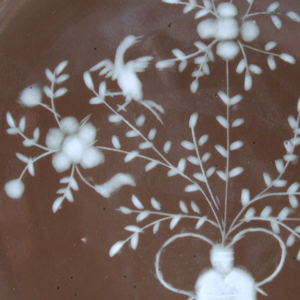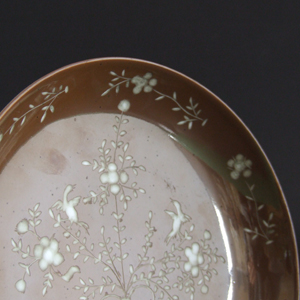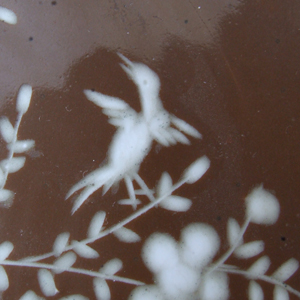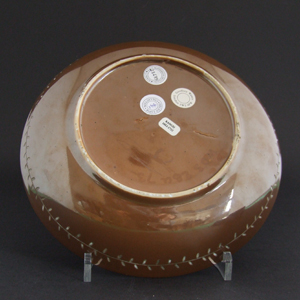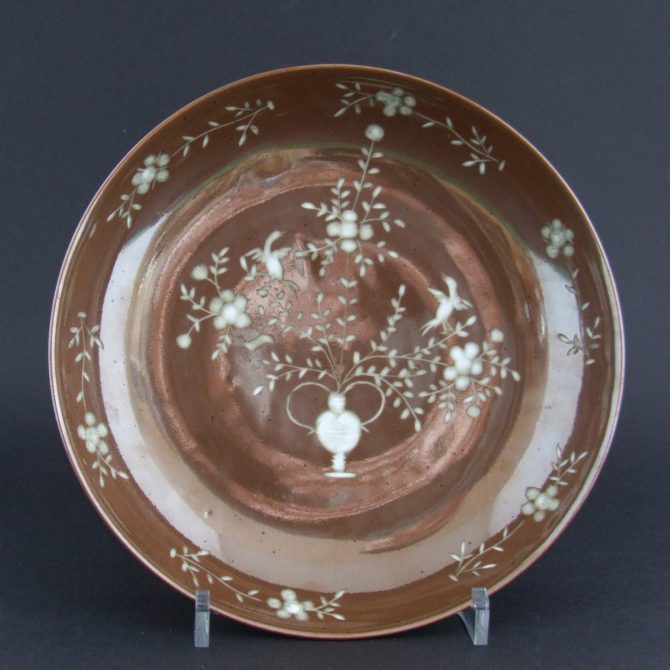
KANGXI or YONGZHENG c.1710 – 1730 Wheel – Engraved in Saxony
A Rare Late Kangxi or Yongzheng `Batavian Ware` Saucer Shaped Dish c.1710-1730. Wheel Engraved in Saxony c.1720-1730. Decorated with a Metal Vase Containing Flowering Plants with Birds. Some of the Wheel Engraved Decoration Shows Traces of Gilding.
SOLD
- Condition
- Perfect.
- Size
- Diameter : 21 cm (8 1/4 inches)
- Provenance
- Geoffrey Waters, Kings Road, London. October 7th 1995. The Helen Espir Collection of European Decorated Chinese Export Porcelain : "a member of the Oriental Ceramic Society and collector, with her husband. Having made a typical collection of Song and provincial Ming blue and white, they decided to concentrate on what used to be called `clobbered` porcelain. She is the author of the standard work on the subject, European Decoration on Oriental Porcelain,2005, the first to examine the work of European decorators on Chinese porcelain throughout the eighteenth and nineteenth centuries, focusing on enamellers in Holland, Germany and England. She has learned Chinese." From Provenance ; Collectors, Dealers & Scholars : Chinese Ceramics in Britain & America (Roy Davids, Dominic Jellinek, Privately Printed, 2011. ISBN 978-0-9570148-0-0).
- Stock number
- 23639
Information
It is highly usual to find such a large object with wheel-engraving. Most pieces from this usual group are tea wares.
Batavia Ware :
Iron-oxide is possibly the most important colouring agent for glazes and it has been used in many ways over thousands of years to decorate Chinese ceramics. By controlling oxygen levels in the kiln as well as the amount of iron used in the glaze, a large variety of colours can be achieved. High concentrations of iron-oxide, around 5%, were used to colour the glaze to the deep rich brown that has become known as Batavia Ware, named after the V.O.C. trans-shipping town, rather than where the porcelain was made. The colour was added in the form of iron filings, occasionally one or two of them can be seen in the glaze. A Lesser amounts of iron-oxide would give the paler glaze colour known as Cafe au Lait. Both these glazes were used in conjunction with Blue and White, Famille Verte, Famille Rose as well as Imari decoration and were used on Chinese export ware during the 18th century.
Wheel-Engraving on Chinese Export Porcelain :
Wheel-engraving was one of a number of techniques employed by Europeans to enliven Chinese porcelain. It is not often encountered. It is essentially a German glass decorating technique that was suited to the glaze of Chinese porcelain. By cutting deeply, the skilled engraver was able to remove the glaze completely, exposing the brilliant white porcelain, this contrasted well with the rich brown of the Batavia ware or other coloured glazes found on Chinese porcelain. Wheel engraving was practiced at Dresden, Bohemia and Silesia in the 17th and 18th centuries. For similar teabowls and saucers with this type of decoration see : European Decoration on European Porcelain 1700 - 1830 (Helen Espir,Jorge Welsh Books, 2005) Page 59, Item 12. Helen Espir`s notes about this teabowl and saucer ; "Fig.12 shows two Batavian cups and saucers; on the right wheel engraved with a rare hunting scene..". A Teabowl and saucer with this type of decoration is on display in the Victoria and Albert Museum in London reference V&A : 306 & A-1895. It is published in : Chinese Export Ceramics (Rose Kerr, Luisa Mengoni, Ming Wilson, V&A Publishing 2011. ISBN 9781-85177-6320) page 97, plate 137.
